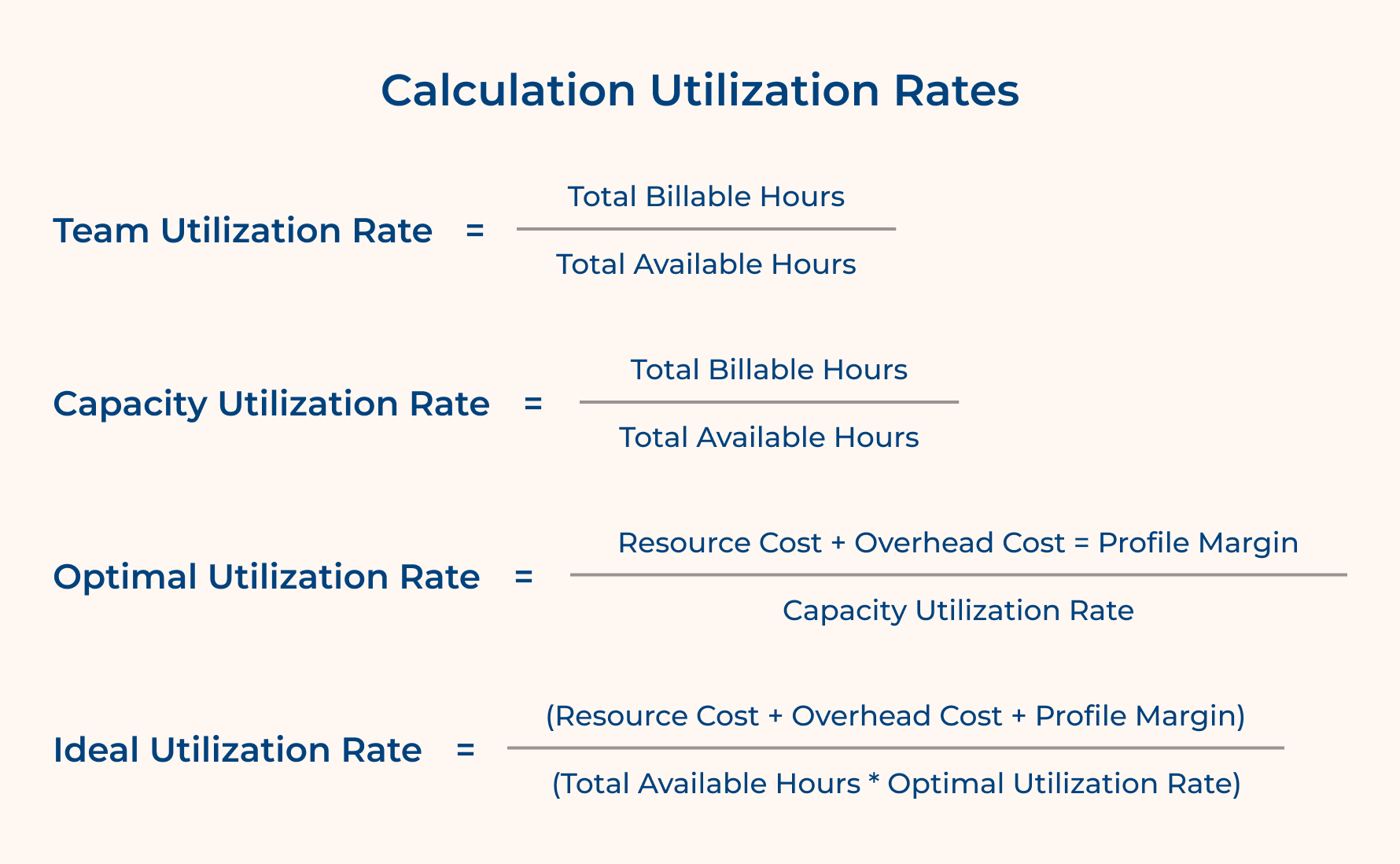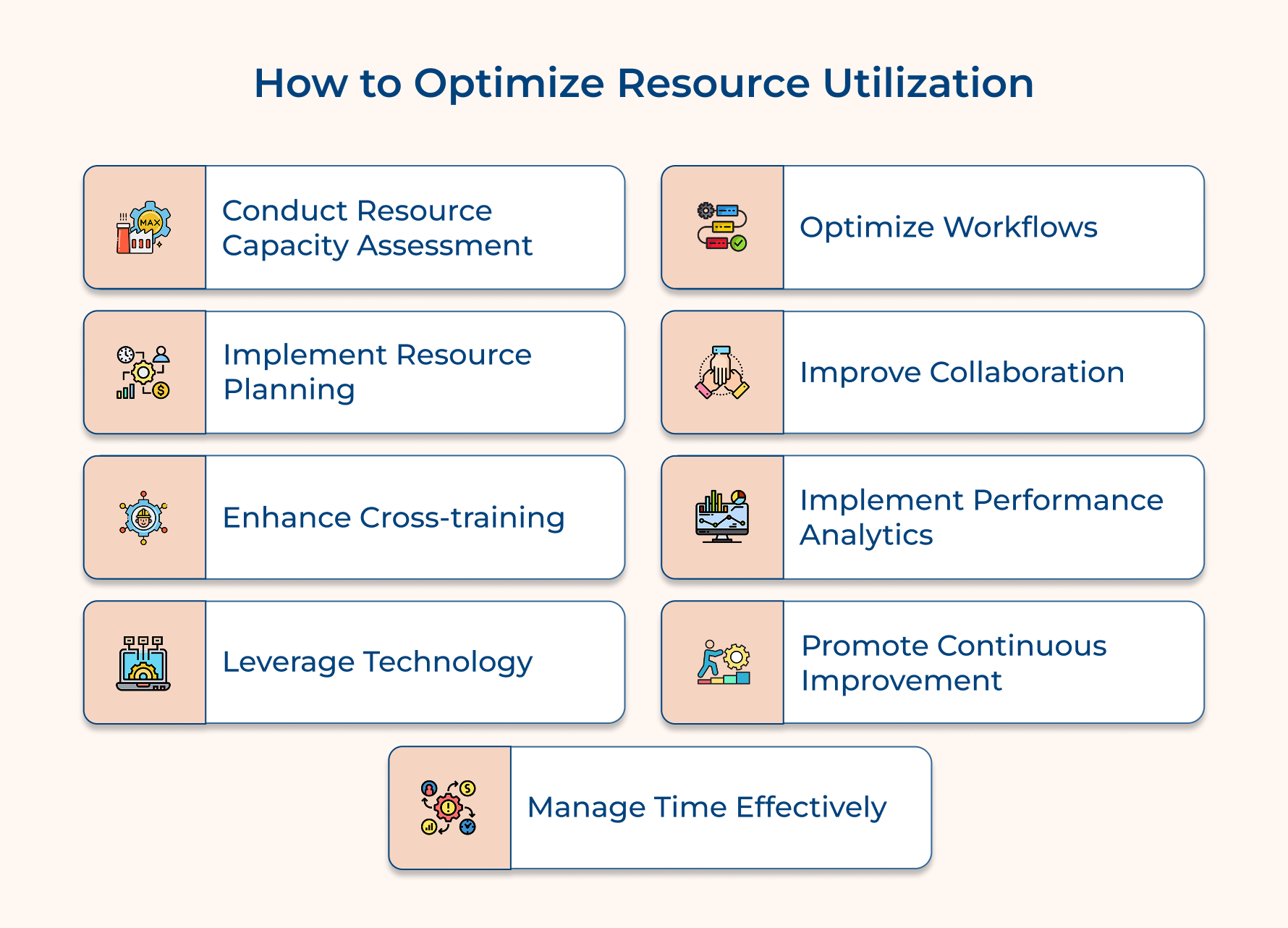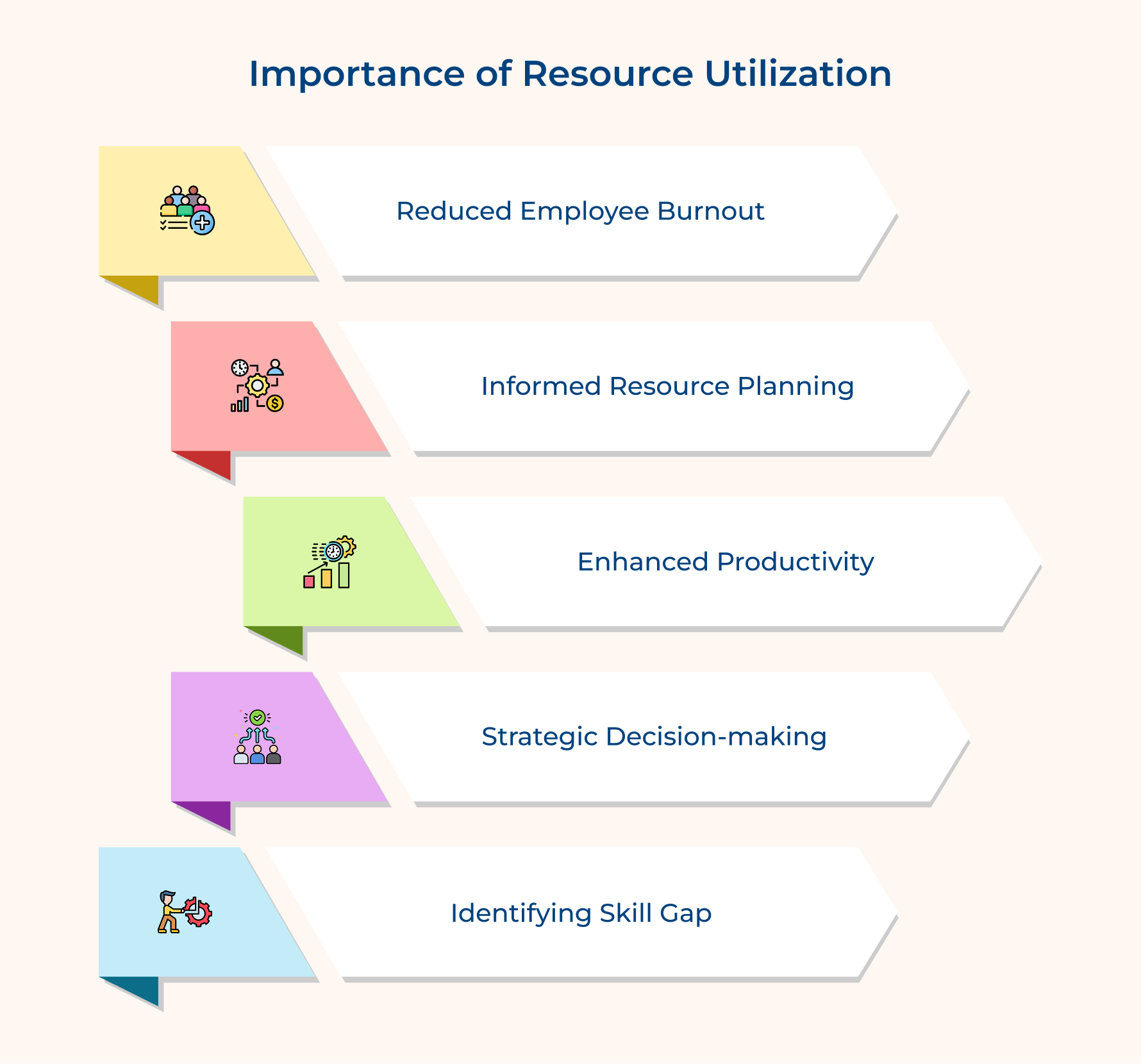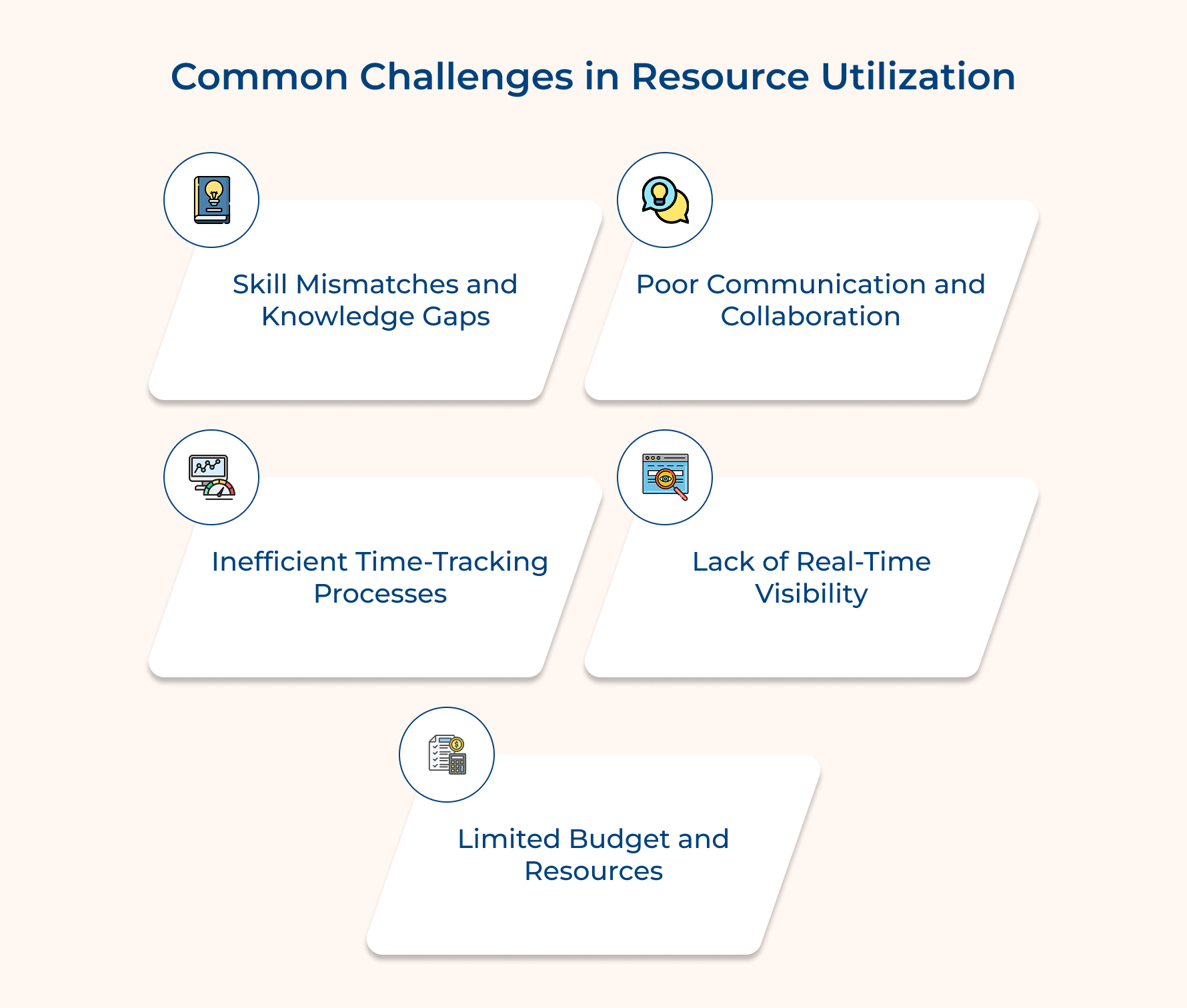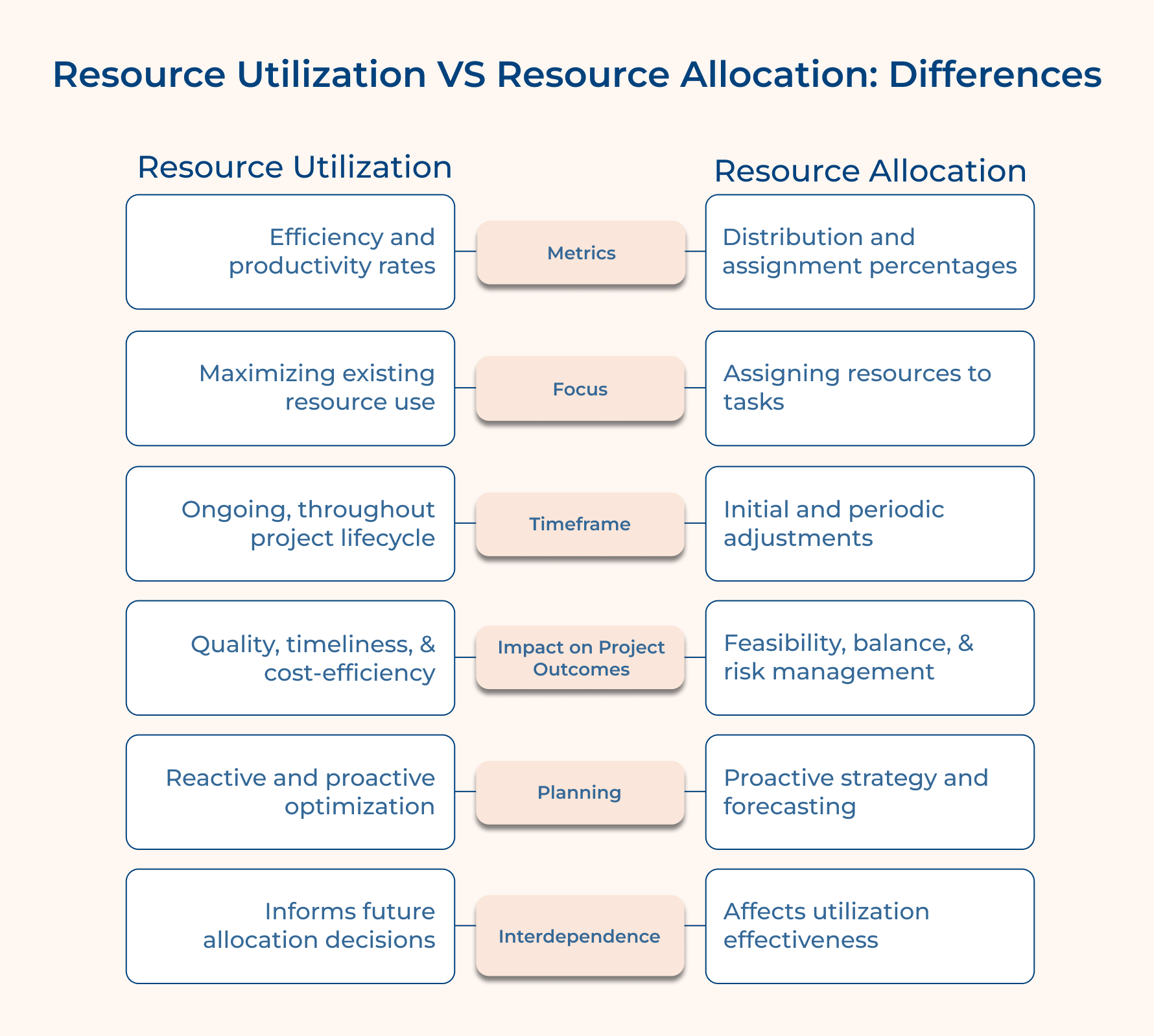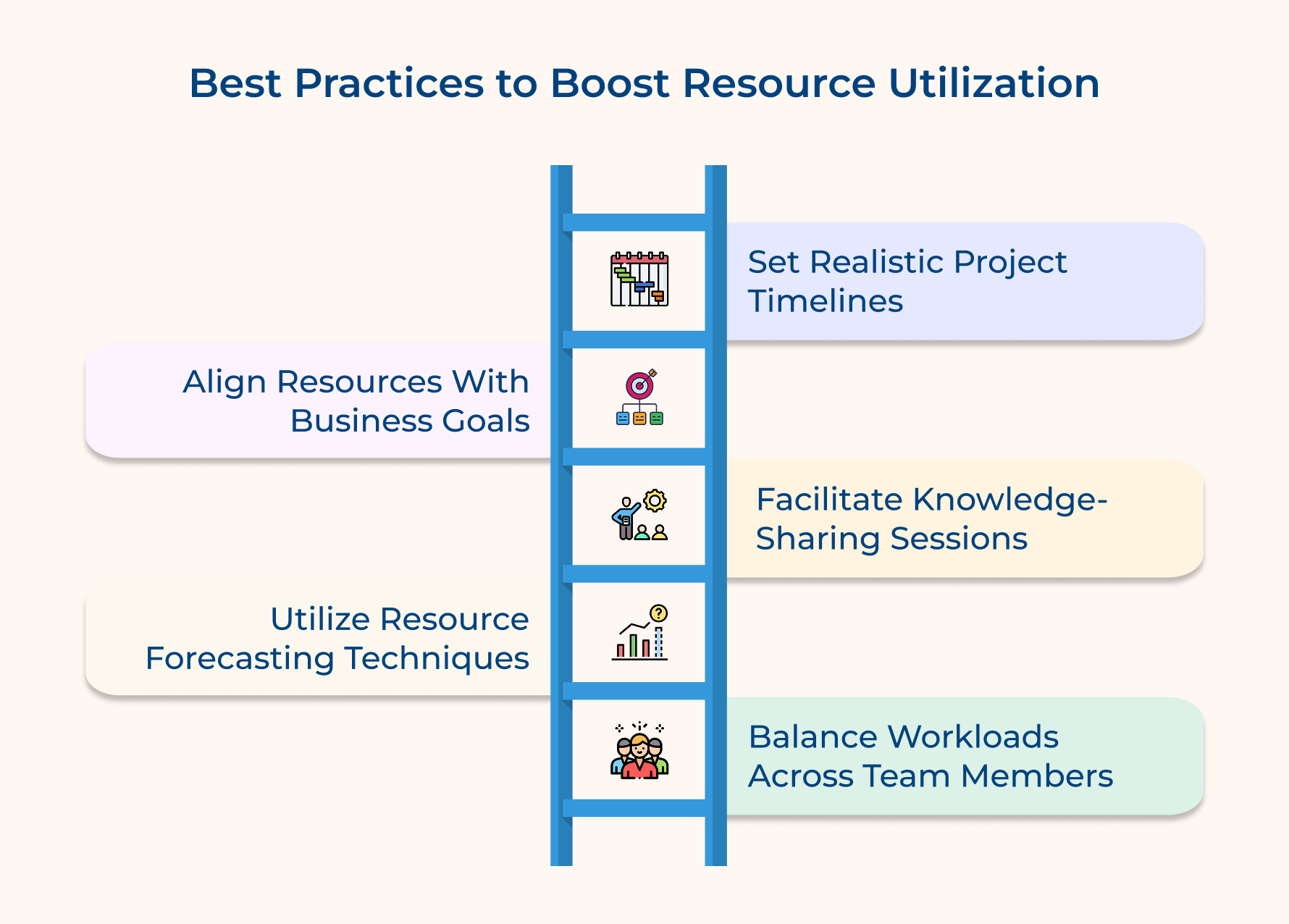What is Resource Utilization? Formula, Benefits & Examples
- What is Resource Utilization: Definition
- How to Calculate Resource Utilization?
- How to Optimize Resource Utilization: 9 Strategies
- Importance of Resource Utilization
- What are The Common Challenges in Resource Utilization?
- Resource Utilization VS Resource Allocation: Differences
- Best Practices to Boost Resource Utilization
- Mastering Success with Effective Resource Utilization
- FAQs about Resource Utilization

Key Highlights
Many service-based businesses struggle with inefficient resource management, leading to project delays and increased costs. A disproportionate usage of finances, time, talent and other resources significantly jeopardizes the ability to meet client expectations – which is crucial for sustaining long-term relationships.
Organizations that fail to optimize resources risk falling behind, leading to client dissatisfaction and lost revenue opportunities.
Adopting a structured approach to resource utilization allows agencies to streamline operations, and enhance productivity. Let’s explore strategies to transform your resource management, ensuring your team operates at peak efficiency and your business achieves sustainable growth.
What is Resource Utilization: Definition
Resource utilization refers to the strategic allocation and management of human, financial, as well as physical resources to optimize efficiency while achieving project goals. It involves measuring how effectively these resources are employed in delivering services to clients, ensuring that personnel are appropriately assigned to tasks based on their skills and availability.
Effective resource utilization ensures that skilled professionals are assigned to appropriate projects, billable hours are maximized, and project deadlines are met without overextending the team. Proper resource management also helps maintain a healthy work-life balance for employees, reducing burnout and turnover.
Key objectives:
- Maximizing productivity: Ensuring that resources are engaged in high-value activities to boost overall output and efficiency.
- Controlling costs: Reducing waste and unnecessary expenditures by aligning resource allocation with project requirements.
- Enhancing quality of service: Utilizing the right skills and expertise to deliver superior results, building client trust as well as satisfaction.
How to Calculate Resource Utilization?
Calculating resource utilization is essential for understanding how effectively resources are being used in a project. Here’s a guide on how to calculate resource utilization:
1. Define Resource Capacity
Start by determining the total available capacity of the resource over a specific period. It involves understanding the working hours or capacity limits of each resource.
For example, if a team member works 40 hours a week, their capacity is 40 hours. For teams or departments, sum the capacity of all members. Consider factors like holidays, vacations and downtime, as these can affect overall capacity.
2. Measure Actual Resource Usage
Track the actual hours worked or resources used during the same period. It generally includes time spent on specific tasks, projects, or general activities. Utilize time-tracking tools or project management software to gather accurate data.
3. Use the Resource Utilization Formula
The formula gives you a percentage that indicates how much of the available capacity was utilized. A utilization rate of 75% means that the resource was effectively engaged for three-quarters of its capacity, while a rate of 50% indicates underutilization. The percentage helps in benchmarking against industry standards or organizational goals.
The formula for calculating resource utilization is:
4. Analyze the Results
A utilization rate of 100% means resources are fully utilized, while rates below that indicate underutilization. High rates (over 100%) may suggest overuse or burnout, which can lead to decreased quality of work and employee dissatisfaction.
Analyze trends over time to identify consistent patterns and assess if adjustments are needed in workload distribution or resource allocation.
5. Review Regularly
Conduct regular reviews of resource utilization to monitor trends over time. It allows for timely adjustments to resource allocation and project management strategies. Set a schedule for these reviews—monthly or quarterly—and involve key stakeholders to discuss findings as well as implications.
How to Optimize Resource Utilization: 9 Strategies
Optimizing resource utilization in project management is vital for boosting productivity, enhancing performance, and improving project outcomes. Here are the key methods to implement.
1. Conduct Resource Capacity Assessment
Resource capacity assessment is crucial for professional services firms to understand their current workforce capabilities, identify skill gaps, and determine the optimal allocation of resources across projects. It provides a clear picture of available capacity, enabling firms to make informed decisions about taking on new projects or reallocating resources.
Firms can use capacity assessment to create a comprehensive inventory of their resources, including skills, experience, and availability. The information can be used to match the right people to the right projects, identify areas where additional training or hiring is needed, and ensure a balanced workload across the team.
Tips:
- Regularly update your resource database to maintain accurate information on skills and availability.
- Use specialized resource management tools to streamline the assessment process and generate insightful reports.
2. Implementing Resource Planning and Allocation
Effective resource planning ensures that projects are adequately staffed, deadlines are met, and resources are used efficiently. It helps prevent overallocation or underutilization of team members, leading to improved productivity along with project success rates.
Firms can implement resource planning tools to forecast project needs, assign team members based on their skills, and adjust allocations as project requirements change. The approach allows for better workload balancing as well as helps identify potential resource conflicts early.
Tips:
- Develop a centralized resource allocation system that provides real-time visibility into resource availability and assignments.
- Involve resource managers along with team leads in the allocation process to ensure accurate estimations and appropriate skill matching.
3. Enhancing Skills and Cross-training
Continuous skill enhancement and cross-training are essential in the rapidly evolving professional services environment. It increases team versatility, improves problem-solving capabilities, and allows for more flexible resource allocation. Hence, leading to higher-quality deliverables and client satisfaction.
Firms can implement regular training programs, mentorship initiatives, and knowledge-sharing sessions to upskill their workforce. Cross-training employees in complementary skills enable them to take on diverse roles and fill in for colleagues when needed, improving overall team flexibility.
Tips:
- Create individualized learning paths for employees based on their career goals and the firm’s strategic needs.
- Encourage peer-to-peer learning and establish a knowledge base to facilitate continuous skill development.
4. Leveraging Technology and Automation
Technology and automation increase efficiency, reducing manual errors, while freeing up skilled professionals to focus on high-value tasks. It enables firms to handle larger workloads, improve accuracy, and deliver services more quickly, giving them a competitive edge in the market.
Firms can implement project management software, automated reporting tools, and AI-powered analytics to streamline workflows along with decision-making processes. Automation can handle repetitive administrative tasks, freeing up time for skilled professionals to focus on strategic and billable tasks.
Tips:
- Conduct a thorough analysis of current processes to identify areas where automation can provide the most significant impact.
- Provide comprehensive training and support to ensure the smooth adoption of new technologies across the organization.
5. Optimizing Workflows and Processes
The synonyms for optimized workflows are maximizing productivity and ensuring consistent quality of service. They ensure better resource allocation and help prioritize billable projects for maximum profitability.
Firms can map out their current processes, identify inefficiencies, and redesign workflows to eliminate redundancies while streamlining their operations. It may involve standardizing procedures, implementing best practices, and using process management tools to ensure consistency across projects.
Tips:
- Involve team members in the process optimization effort to gain valuable insights and increase buy-in.
- Regularly review processes to adapt to changing business needs and technological advancements.
6. Improving Communication and Collaboration
Effective communication assures team members’ alignment, reducing misunderstandings and building a productive work environment. They enable faster problem-solving, better knowledge sharing, and more cohesive project execution.
Firms can implement collaboration tools, establish clear communication channels, and create protocols for sharing information across teams. Regular team meetings, project updates, and collaborative workspaces can facilitate better information flow as well as decision-making.
Tips:
- Establish clear communication guidelines and expectations for different types of interactions as well as projects.
- Invest in user-friendly collaboration tools that integrate well with existing systems and workflows.
7. Implementing Performance Monitoring and Analytics
Performance monitoring and analytics provide helpful insights into resource utilization, project progress, overall productivity, etc. They enable data-driven decision-making, help identify areas for improvement, and allow for timely interventions to keep projects on track.
Firms can implement key performance indicators (KPIs) and use analytics tools to track resource utilization rates, project profitability, individual performance, etc. Analytics tools can help distinguish between billable tasks and non-billable hours, ensuring accurate profitability tracking.
Tips:
- Define clear, measurable KPIs that align with the firm’s strategic goals and operational needs.
- Provide training on how to interpret and act on performance data to drive continuous improvement.
8. Building a Culture of Continuous Improvement
A culture of continuous improvement encourages innovation, adaptability, and efficiency. It empowers employees to identify and address inefficiencies, leading to ongoing optimization of resource utilization along with overall productivity gains.
Firms get to implement feedback loops, encourage idea sharing, and recognize employees for improvement suggestions. Regular retrospectives and lessons learned sessions can be used to refine processes as well as identify best practices for future projects.
Tips:
- Establish a formal system for collecting, evaluating, and implementing improvement ideas from all levels of the organization.
- Celebrate and reward successful improvement initiatives to reinforce the importance of continuous enhancement.
9. Managing Time Effectively
Effective time management not only maximizes productivity but ensures optimal resource utilization. It helps professionals prioritize tasks, meet deadlines, and maintain a healthy work-life balance, leading to improved job satisfaction as well as overall performance.
Firms can implement time-tracking tools to record actual time spent on tasks. It also encourages the use of productivity techniques like the Pomodoro method and provides training on effective time management strategies.
Tips:
- Encourage the use of time-blocking techniques to help employees focus on high-priority tasks without interruptions.
- Regularly review time allocation data to identify patterns and opportunities for improvement in resource utilization.
Importance of Resource Utilization
Understanding the importance of resource utilization enables organizations to maximize efficiency. Here are the reasons why resource utilization matters.
1. Reduced Employee Burnout
Effective resource and project utilization ensures a balanced workload distribution, preventing the overallocation of tasks to specific team members. The balanced approach maintains employee well-being, reduces stress, and minimizes burnout risk. A healthier work environment promotes improved job satisfaction, retention, and long-term productivity.
2. Informed Resource Planning
Resource utilization data provides crucial insights for future planning. Understanding current resource usage allows managers to make accurate predictions about future needs, identify potential bottlenecks, and plan for capacity changes. The informed approach results in more efficient resource allocation and smoother project execution.
3. Enhanced Productivity
Optimizing resource utilization directly translates to increased productivity. Efficient resource use enables teams to accomplish more in less time. Project delivery timelines improve, and the organization can take on additional work, potentially increasing revenue without necessarily expanding the workforce.
4. Strategic Decision-Making
Resource utilization metrics offer useful data for strategic decisions for leadership roles. They get to identify the most profitable services/projects, high-performing teams, and areas of inefficiency. The information guides decisions on resource investment, service offerings, and overall business strategy, ensuring alignment with organizational goals.
5. Identifying Skill Gaps
Careful monitoring of resource utilization helps identify areas where skills are lacking or underutilized. The insight enables targeted training & development initiatives, strategic hiring decisions, as well as effective knowledge transfer within the organization. Addressing skill gaps enhances service offerings and competitive positions.
What are The Common Challenges in Resource Utilization?
Identifying common Challenges in resource utilization is essential for improvement. Overcoming these challenges can significantly enhance project success. Here are the main challenges organizations face.
1. Skill Mismatches and Knowledge Gaps
Skill mismatches and knowledge gaps can hinder effective resource utilization, as team members may not possess the necessary competencies for their assigned tasks.
How to resolve: Investing in training and development programs tailored to bridge these gaps is essential. Regular assessments help identify specific skills needed, allowing firms to create targeted learning opportunities. Encouraging a culture of continuous learning creates employee engagement and enhances overall resource effectiveness.
2. Poor Communication and Collaboration
Poor communication and collaboration lead to misunderstandings as well as inefficiencies which significantly impact overall resource utilization.
How to resolve: Establishing clear communication channels would mean encouraging open dialogue among team members. Collaborative tools, such as project management software, facilitate information sharing and improve coordination. Regular team meetings promote alignment on project goals and tasks, creating a collaborative environment that enhances resource utilization.
3. Inefficient Time-Tracking Processes
Inefficient time-tracking processes lead to inaccuracies in resource utilization assessments, making it difficult to allocate resources effectively.
How to resolve: Adopting user-friendly time management tools simplifies the recording of work hours. Providing training on these tools helps employees track their time accurately. Establishing clear guidelines for on-time reporting enhances accountability and ensures more reliable data for evaluating resource utilization.
4. Lack of Real-Time Visibility
A lack of real-time visibility into resource allocation and utilization prevents organizations from making informed decisions.
How to resolve: Implementing resource management software that offers real-time analytics and dashboards provides insights into resource availability, workload distribution, as well as utilization rates. Enhanced visibility creates better planning and optimizes resource deployment across projects, enabling managers to identify issues as well as make timely adjustments.
5. Limited Budget and Resources
Limited budgets and resources can restrict an organization’s ability to optimize resource utilization.
How to resolve: Prioritizing resource allocation based on project impact and strategic goals is essential. Conducting a thorough analysis of existing resources helps identify areas for improvement or reallocation. Exploring partnerships or outsourcing certain tasks provides access to external resources, ensuring that critical projects receive the necessary support without overspending.
Resource Utilization VS Resource Allocation: Differences
Distinguishing between resource utilization and resource allocation is vital for effective management. Here are the primary differences to consider.
Metrics
Resource utilization metrics focus on efficiency, measuring the percentage of available time spent on productive or billable work. Common metrics include utilization rate and billable hours percentage.
Resource allocation metrics assess the distribution of resources across projects or tasks, such as resource load, allocation percentage, and capacity vs. demand ratios.
Focus
Resource utilization centers on maximizing the productive use of available resources, aiming to optimize efficiency and productivity. It focuses on how effectively resources are being used once assigned.
Resource allocation concentrates on the strategic distribution of resources across various projects or tasks, ensuring the right resources are assigned to the right activities at the right time.
Timeframe
Typically measured in real-time or over short periods, resource utilization provides insights into current productivity levels and immediate efficiency. It’s an ongoing process throughout project execution.
Conversely, resource allocation is often planned and adjusted periodically. It involves longer-term planning and forecasting, typically aligning with project timelines as well as organizational goals.
Impact on Project Outcomes
Directly affecting project efficiency and profitability, resource utilization maximizes productive time as well as minimizes waste. High utilization leads to faster project completion and improved cost-effectiveness.
Proper resource allocation sets the foundation for project feasibility and timeline adherence. It impacts project success by ensuring the right skills and resources are available when needed.
Planning
When it comes to resource utilization, planning involves strategies to maximize efficiency within current assignments. It typically includes aspects such as optimizing workflows, minimizing non-billable time, and balancing workloads.
The planning for allocation of resources focuses on future needs, involving capacity forecasting, skill matching, and strategic resource distribution across projects. It requires a broader view of organizational needs and project pipelines.
Interdependence
Resource utilization and allocation are closely interdependent. Effective allocation sets the stage for high utilization by matching skills to tasks and balancing workloads.
Conversely, utilization data informs future allocation decisions by highlighting efficiency patterns and resource capabilities. Together, they form a feedback loop that continuously improves resource management along with project performance.
Best Practices to Boost Resource Utilization
Implementing best practices to boost resource utilization ensures organizations optimize their resources. Here are the top practices to consider.
1. Set realistic project timelines: Establishing achievable project timelines is crucial for effective resource utilization. Conduct thorough project scoping, considering historical data and team capacity. Involve key stakeholders in timeline planning to ensure accuracy.
Build in buffer time for unexpected challenges. Regularly review and adjust timelines as projects progress, maintaining flexibility while keeping resources optimally engaged throughout the project lifecycle.
2. Align resources with business goals: Ensure resource allocation aligns with overarching business objectives. Regularly review and prioritize projects based on strategic importance. Develop a clear understanding of how each project contributes to organizational goals.
Allocate resources to high-priority initiatives first, ensuring that critical projects receive adequate support. This alignment maximizes the impact of resource utilization on overall business success.
3. Facilitate knowledge-sharing sessions: Implement regular knowledge-sharing sessions to enhance team capabilities. Encourage experts to conduct workshops on their specialties. Create a platform for team members to share project learnings and best practices.
Create a culture of continuous learning and collaboration. This practice broadens skill sets, improves problem-solving abilities, and enables more flexible resource allocation across various projects.
4. Utilize resource forecasting techniques: Employ advanced forecasting methods to anticipate future resource needs. Analyze historical data and industry trends to predict upcoming demand.
Use scenario planning to prepare for various possible outcomes. Implement rolling forecasts to regularly update projections. The proactive approach enables better long-term resource planning, helping to avoid both over-allocation and under-utilization of resources.
5. Balance workloads across team members: Strive for equitable distribution of work among team members. Regularly assess individual workloads and adjust assignments as needed.
Consider skill levels, experience, and personal development goals when allocating tasks. Implement a system for team members to flag when they’re over- or under-utilized. This balanced approach prevents burnout, enhances job satisfaction, and ensures optimal use of the entire team’s capabilities.
Mastering Success with Effective Resource Utilization
Effective resource utilization ensures that projects are completed on time and within budget, reducing the likelihood of overruns as well as delays. Aligning resources with project goals enables teams to work more efficiently. Understanding utilization rates is essential for effective resource planning, allowing firms to allocate personnel, equipment, and finances strategically.
Insight into resource usage helps organizations identify potential bottlenecks and adjust allocations proactively. Focusing on resource utilization directly impacts project profitability. Efficient resource management minimizes waste and maximizes output, leading to improved financial outcomes.
Limit time — not creativity
Everything you need for customer support, marketing & sales.
Neeti Singh is a passionate content writer at Kooper, where he transforms complex concepts into clear, engaging and actionable content. With a keen eye for detail and a love for technology, Tushar Joshi crafts blog posts, guides and articles that help readers navigate the fast-evolving world of software solutions.
